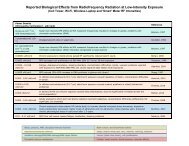Evidence for Effects on Neurology and Behavior - BioInitiative Report
Evidence for Effects on Neurology and Behavior - BioInitiative Report
Evidence for Effects on Neurology and Behavior - BioInitiative Report
Create successful ePaper yourself
Turn your PDF publications into a flip-book with our unique Google optimized e-Paper software.
oxidase inhibitors, but was not significantly affected by serot<strong>on</strong>in [Lobanova, 1974a]. Some of<br />
these results can be explained by the pharmacological properties of the drug tested. Pentobarbital<br />
<strong>and</strong> chloral hydrate are hypnotic agents <strong>and</strong> are known to have antic<strong>on</strong>vulsant effects.<br />
Chlorpromazine, nicotine, <strong>and</strong> m<strong>on</strong>oamine oxidase inhibitors can lower the seizure threshold or<br />
induce c<strong>on</strong>vulsi<strong>on</strong>s depending <strong>on</strong> their dosages. Atropine, a cholinergic antag<strong>on</strong>ist, has been<br />
shown to enhance the seizure threshold. It is puzzling that bemegride decreased RFR induced<br />
seizures, since it is a nervous system stimulant with similar pharmacological acti<strong>on</strong>s as the<br />
c<strong>on</strong>vulsant pentylenetetrazol.<br />
Exposure to pulsed RFR (7 <strong>and</strong> 20 mW/cm 2 ) was reported to affect the effects of the<br />
c<strong>on</strong>vulsants, pentylenetetrazol <strong>and</strong> strychnine, <strong>on</strong> EEG activity [Baranski <strong>and</strong> Edelwejn, 1974].<br />
Another study showed that low-level RFR altered the sensitivity of animals to the seizure<br />
inducing effect of pentylenetetrazol [Servantie et al., 1974]. Rats <strong>and</strong> mice were subjected to 8-<br />
36 days of pulsed RFR (3000 MHz, 0.9-1.2 s pulses, 525 pps, 5 mW/cm 2 ). No significant<br />
change in susceptibility to the drug was seen after eight days of exposure; however, a decrease<br />
in susceptibility was observed after 15 days, <strong>and</strong> an increase in susceptibility was observed after<br />
20, 27, <strong>and</strong> 36 days of irradiati<strong>on</strong>. Mice became more susceptible to the c<strong>on</strong>vulsive effect of<br />
pentylenetetrazol <strong>and</strong> more animals died from c<strong>on</strong>vulsi<strong>on</strong>s. Thus, the sensitivity of the nervous<br />
system to the c<strong>on</strong>vulsive acti<strong>on</strong> of the drug changed as a functi<strong>on</strong> of the durati<strong>on</strong> of exposure. In<br />
another study, Pappas et al. [1983] showed in the rat that acute (30 min) exposure to 2700-MHz<br />
pulsed RFR at 5, 10, 15, <strong>and</strong> 20 mW/cm 2 (SARs 0.75, 1.5, 2.25, <strong>and</strong> 3.0 W/kg, respectively)<br />
produced no significant interacti<strong>on</strong> effect <strong>on</strong> pentylenetetrazol induced seizure or the efficacy of<br />
chlordiazepoxide (an antic<strong>on</strong>vulsant) to block the seizure.<br />
Drugs affecting cholinergic functi<strong>on</strong>s in the nervous system have also been studied.<br />
Chr<strong>on</strong>ic RFR-exposed rats (10-15 days) were found to be less susceptible to the paralytic effect<br />
of curare-like drugs, which block nicotinic cholinergic transmissi<strong>on</strong>. A similar effect was<br />
observed <strong>on</strong> muscle preparati<strong>on</strong>s from the irradiated rats. Presumably, the cholinergic<br />
transmissi<strong>on</strong> in the neuromuscular juncti<strong>on</strong> was affected by RFR. Ashani et al. [1980] reported<br />
that acute pulsed RFR (10 min, 10 mW/cm 2 ) enhanced the hypothermic effects of an inhibitor of<br />
AChE (the degradati<strong>on</strong> enzyme of acetylcholine). The site of this effect was determined to be<br />
located inside the central nervous system. M<strong>on</strong>ahan [1988] also reported that RFR (2450 MHz,<br />
c<strong>on</strong>tinuous-wave, whole body SARs 0.5-2.0 W/kg) affected the acti<strong>on</strong>s of scopolamine, a<br />
cholinergic antag<strong>on</strong>ist, <strong>and</strong> physostigmine, a cholinergic ag<strong>on</strong>ist, <strong>on</strong> motor activity of mice in a<br />
maze. The data suggested enhancement of cholinergic activity after RFR irradiati<strong>on</strong>.<br />
Several studies investigated the acti<strong>on</strong>s of benzodiazepines, a group of drugs used <str<strong>on</strong>g>for</str<strong>on</strong>g><br />
antic<strong>on</strong>vulsi<strong>on</strong>, sedati<strong>on</strong>-hypnosis, <strong>and</strong> antianxiety purposes. Two of the most comm<strong>on</strong>ly used<br />
benzodiazepines <str<strong>on</strong>g>for</str<strong>on</strong>g> the treatment of anxiety disorders are chlordiazepoxide (Librium) <strong>and</strong><br />
diazepam (Valium). Low-level pulsed RFR (1 mW/cm 2 , whole body SAR 0.2 W/kg)<br />
potentiated the effect of chlordiazepoxide <strong>on</strong> bar-pressing behavior of rats working <strong>on</strong> a DRLschedule<br />
<str<strong>on</strong>g>for</str<strong>on</strong>g> food rein<str<strong>on</strong>g>for</str<strong>on</strong>g>cement; however, the same authors also reported no interacti<strong>on</strong> effects<br />
between RFR <strong>and</strong> diazepam <strong>on</strong> bar pressing [Thomas et al., 1979, 1980].<br />
Increase in brain benzodiazepine receptors in the brain after RFR exposure [Lai et al,<br />
1992a] could explain the <str<strong>on</strong>g>for</str<strong>on</strong>g>mer effect. A possible explanati<strong>on</strong> <str<strong>on</strong>g>for</str<strong>on</strong>g> the discrepancy of the results<br />
observed with chlordiazepoxide <strong>and</strong> diazepam was that diazepam has a higher potency than<br />
chlordiazepoxide. The potency of diazepam that was effective in attenuati<strong>on</strong> of experimental<br />
c<strong>on</strong>flict, an animal model of anxiety, was about four times that of chlordiazepoxide [Lippa et al.,<br />
1978], <strong>and</strong> the in vitro relative affinity of diazepam with benzodiazepine receptors was 30-65<br />
46



